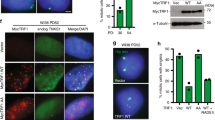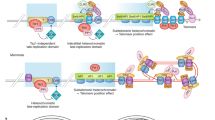Abstract
Most human somatic cells can undergo only a limited number of population doublings in vitro1. This exhaustion of proliferative potential, called senescence, can be triggered when telomeres—the ends of linear chromosomes—cannot fulfil their normal protective functions. Here we show that senescent human fibroblasts display molecular markers characteristic of cells bearing DNA double-strand breaks. These markers include nuclear foci of phosphorylated histone H2AX and their co-localization with DNA repair and DNA damage checkpoint factors such as 53BP1, MDC1 and NBS1. We also show that senescent cells contain activated forms of the DNA damage checkpoint kinases CHK1 and CHK2. Furthermore, by chromatin immunoprecipitation and whole-genome scanning approaches, we show that the chromosome ends of senescent cells directly contribute to the DNA damage response, and that uncapped telomeres directly associate with many, but not all, DNA damage response proteins. Finally, we show that inactivation of DNA damage checkpoint kinases in senescent cells can restore cell-cycle progression into S phase. Thus, we propose that telomere-initiated senescence reflects a DNA damage checkpoint response that is activated with a direct contribution from dysfunctional telomeres.
This is a preview of subscription content, access via your institution
Access options
Subscribe to this journal
Receive 51 print issues and online access
$199.00 per year
only $3.90 per issue
Buy this article
- Purchase on SpringerLink
- Instant access to full article PDF
Prices may be subject to local taxes which are calculated during checkout




Similar content being viewed by others
References
Hayflick, L. & Moorhead, P. S. The limited in vitro lifetime of human diploid cell strains. Exp. Cell Res. 25, 585–621 (1961)
Bodnar, A. G. et al. Extension of life-span by introduction of telomerase into normal human cells. Science 279, 349–352 (1998)
Shiloh, Y. ATM and related protein kinases: safeguarding genome integrity. Nature Rev. Cancer 3, 155–168 (2003)
Nyberg, K. A., Michelson, R. J., Putnam, C. W. & Weinert, T. A. Toward maintaining the genome: DNA damage and replication checkpoints. Annu. Rev. Genet. 36, 617–656 (2002)
Lou, Z., Minter-Dykhouse, K., Wu, X. & Chen, J. MDC1 is coupled to activated CHK2 in mammalian DNA damage response pathways. Nature 421, 957–961 (2003)
Stewart, G. S., Wang, B., Bignell, C. R., Taylor, A. M. R. & Elledge, S. J. MDC1 is a mediator of the mammalian DNA damage checkpoint. Nature 421, 961–966 (2003)
Goldberg, M. et al. MDC1 is required for the intra-S-phase DNA damage checkpoint. Nature 421, 952–956 (2003)
Webley, K. et al. Posttranslational modifications of p53 in replicative senescence overlapping but distinct from those induced by DNA damage. Mol. Cell. Biol. 20, 2803–2808 (2000)
de Lange, T. Protection of mammalian telomeres. Oncogene 21, 532–540 (2002)
Karlseder, J., Broccoli, D., Dai, Y., Hardy, S. & de Lange, T. p53- and ATM-dependent apoptosis induced by telomeres lacking TRF2. Science 283, 1321–1325 (1999)
Smogorzewska, A. & De Lange, T. Different telomere damage signaling pathways in human and mouse cells. EMBO J. 21, 4338–4348 (2002)
Martens, U. M. et al. Short telomeres on human chromosome 17p. Nature Genet. 18, 76–80 (1998)
van Steensel, B., Smogorzewska, A. & de Lange, T. TRF2 protects human telomeres from end-to-end fusions. Cell 92, 401–413 (1998)
Freire, R. et al. Human and mouse homologs of Schizosaccharomyces pombe rad1+ and Saccharomyces cerevisiae RAD17: linkage to checkpoint control and mammalian meiosis. Genes Dev. 12, 2560–2573 (1998)
Lukas, C., Falck, J., Bartkova, J., Bartek, J. & Lukas, J. Distinct spatiotemporal dynamics of mammalian checkpoint regulators induced by DNA damage. Nature Cell Biol. 5, 255–260 (2003)
Canman, C. E. et al. Activation of the ATM kinase by ionizing radiation and phosphorylation of p53. Science 281, 1677–1679 (1998)
Cliby, W. A. et al. Overexpression of a kinase-inactive ATR protein causes sensitivity to DNA-damaging agents and defects in cell cycle checkpoints. EMBO J. 17, 159–169 (1998)
Heffernan, T. P. et al. An ATR- and Chk1-dependent S checkpoint inhibits replicon initiation following UVC-induced DNA damage. Mol. Cell. Biol. 22, 8552–8561 (2002)
Chehab, N. H., Malikzay, A., Appel, M. & Halazonetis, T. D. Chk2/hCds1 functions as a DNA damage checkpoint in G(1) by stabilizing p53. Genes Dev. 14, 278–288 (2000)
Stoeber, K. et al. DNA replication licensing and human cell proliferation. J. Cell Sci. 114, 2027–2041 (2001)
Schmitt, C. A. Senescence, apoptosis and therapy—cutting the lifelines of cancer. Nature Rev. Cancer 3, 286–295 (2003)
Parrinello, S. et al. Oxygen sensitivity severely limits the replicative lifespan of murine fibroblasts. Nature Cell Biol. 5, 741–747 (2003)
Wong, K. K. et al. Telomere dysfunction impairs DNA repair and enhances sensitivity to ionizing radiation. Nature Genet. 26, 85–88 (2000)
Goytisolo, F. A. et al. Short telomeres result in organismal hypersensitivity to ionizing radiation in mammals. J. Exp. Med. 192, 1625–1636 (2000)
Campisi, J. Cellular senescence as a tumor-suppressor mechanism. Trends Cell Biol. 11, S27–S31 (2001)
Hoeijmakers, J. H. Genome maintenance mechanisms for preventing cancer. Nature 411, 366–374 (2001)
d'Adda di Fagagna, F. et al. Effects of DNA nonhomologous end-joining factors on telomere length and chromosomal stability in mammalian cells. Curr. Biol. 11, 1192–1196 (2001)
Fiegler, H. et al. DNA microarrays for comparative genomic hybridization based on DOP-PCR amplification of BAC and PAC clones. Genes Chromosom. Cancer 36, 361–374 (2003)
Zhao, H., Watkins, J. L. & Piwnica-Worms, H. Disruption of the checkpoint kinase 1/cell division cycle 25A pathway abrogates ionizing radiation-induced S and G2 checkpoints. Proc. Natl Acad. Sci. USA 99, 14795–14800 (2002)
Sorensen, C. S. et al. Chk1 regulates the S phase checkpoint by coupling the physiological turnover and ionizing radiation-induced accelerated proteolysis of Cdc25A. Cancer Cell 3, 247–258 (2003)
Acknowledgements
We thank R. Abraham, C. Aquaviva, J. Bartek, R. Laskey, N. La Thangue, T. de Lange, S. Elledge, T. Halazonetis, M. Kastan and T. Kouzarides for sharing reagents; K. Woodfine for constructing the chromosome 22 array; M. Goldberg for help with immunofluorescence; B. Williams for generating pCHK2-KD; J. Bradbury and K. Dry for editorial help; and D. Baird, J. Bartek, M. Foiani, J. Pines and all the S.P.J. laboratory for suggestions. F.d'A.d.F. was supported by a Cancer Research UK grant, and P.M.R. is supported by a studentship from Cancer Research UK. T.v.Z. acknowledges support from Research into Ageing UK.
Author information
Authors and Affiliations
Corresponding authors
Ethics declarations
Competing interests
The authors declare that they have no competing financial interests.
Supplementary information
Rights and permissions
About this article
Cite this article
Fagagna, F., Reaper, P., Clay-Farrace, L. et al. A DNA damage checkpoint response in telomere-initiated senescence. Nature 426, 194–198 (2003). https://doi.org/10.1038/nature02118
Received:
Accepted:
Published:
Issue Date:
DOI: https://doi.org/10.1038/nature02118
This article is cited by
-
Role of cellular senescence in inflammation and regeneration
Inflammation and Regeneration (2024)
-
Prognostic and therapeutic potential of senescent stromal fibroblasts in prostate cancer
Nature Reviews Urology (2024)
-
Plasma membrane damage limits replicative lifespan in yeast and induces premature senescence in human fibroblasts
Nature Aging (2024)
-
Plasma membrane damage causes cellular senescence
Nature Aging (2024)
-
Mitochondria and telomeres: hand in glove
Biogerontology (2024)



